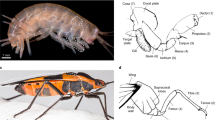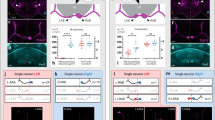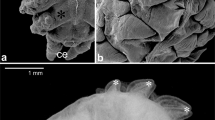Abstract
A prominent feature of most central nervous systems is the presence of highly organized association centres, often called ‘nuclei’ in vertebrate brains and ‘glomeruli’ or ‘neuromeres’ in invertebrate brains and ventral ganglia. As little is known of the processes leading to the formation of these centres, we have investigated this question in the case of the leg neuromeres of Drosophila. The thoracico-abdominal ganglion of wild-type flies contains six conspicuous neuromeres, each associated with a leg1. In bithoraxoid (bxd) mutants, the first abdominal segment is transformed to thoracic, and one or two additional legs may develop2. We show here that supernumerary neuromeres may also be observed in this mutant. However, in a given individual the number of neuromeres is independent of the number of legs. In Hyperabdominal (Hab) mutants, the metathoracic segment is transformed to abdominal, and the metathoracic legs may be missing3. The ganglia of four-legged mutants show a variable reduction of the metathoracic leg neuromeres. We conclude that the formation of a leg neuromere is genetically controlled and does not depend on the presence of a corresponding leg.
This is a preview of subscription content, access via your institution
Access options
Subscribe to this journal
Receive 51 print issues and online access
$199.00 per year
only $3.90 per issue
Buy this article
- Purchase on Springer Link
- Instant access to full article PDF
Prices may be subject to local taxes which are calculated during checkout
Similar content being viewed by others
References
Power, M. E. J. comp. Neurol. 88, 347–409 (1948).
Lewis, E. B. Am. Zool. 3, 33–56 (1963).
Lewis, E. B. Nature 276, 565–570 (1978).
Teugels, E. & Ghysen, A. Prog. Brain Res. 58 (in the press).
Green, S. H. Nature 292, 152–154 (1981).
Köhler, G. & Milstein, C. Nature 256, 495 (1975).
Jimenez, F. & Campos-Ortega, J.A., Wilhelm Roux's Arch. dev. Biol. 190, 370–373 (1981).
Lindsley, D. L. & Grell, E. H. Carnegie Inst. Wash. Publ. 627 (1968).
Capdevila, M. P. & Garcia-Bellido, A. Wilhelm Roux's Arch. dev. Biol. 185, 105–126 (1978).
Author information
Authors and Affiliations
Rights and permissions
About this article
Cite this article
Teugels, E., Ghysen, A. Independence of the numbers of legs and leg ganglia in Drosophila bithorax mutants. Nature 304, 440–442 (1983). https://doi.org/10.1038/304440a0
Received:
Accepted:
Issue Date:
DOI: https://doi.org/10.1038/304440a0
This article is cited by
-
Ultrabithorax protein expression in breakpoint mutants: localization of single, co-operative and redundant cis regulatory elements
Roux's Archives of Developmental Biology (1994)
-
Positive and negative cis-regulatory elements in the bithoraxoid region of the Drosophila Ultrabithorax gene
Molecular and General Genetics MGG (1992)
-
The function ofbithorax genes in the abdominal central nervous system ofDrosophila
Roux’s Archives of Developmental Biology (1986)
-
Domains of action of bithorax genes in Drosophila central nervous system
Nature (1985)
Comments
By submitting a comment you agree to abide by our Terms and Community Guidelines. If you find something abusive or that does not comply with our terms or guidelines please flag it as inappropriate.



